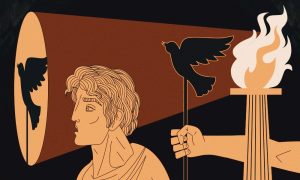Serving: Smiles and Nightmares
May 19, 2015
The lights are dim as Lizbeth Iraheta approaches the restaurant. She hears a familiar tune crackling over the sound system, “Ooh, your kisses (ooh), sweeter than honey (ooh), and guess what (ooh), so is my money (ooh)…” She walks into the bustling restaurant only held down by one server. She heads to the back of the house to prepare for the weekend double shift ahead of her.
“Get ready to clock in Lizbeth,” says a hurried manager throwing dishes onto an overfilled dishrack.
Iraheta nods as she pulls her dark hair into a ponytail, swaps her worn-in Ugg moccasins for practical nonslip black sneakers, and clocks in.
“My name is Lizbeth and I will be your–”
“We’ll have two unsweetened iced teas,” the woman at table twenty-four interjects. “We’re really thirsty.”
Lizbeth holds back from rolling her eyes as the woman interrupts her introduction. Instead she smiles at the lady, remembering that her day just started and that she has twelve hours before going home.
She fills up two water-spotted, chipped plastic glasses with the tea, adorns them with lemon wedges, and brings the drinks to her first table of the day.
“Can we have straws,” asks the woman, even before Lizbeth places the drinks down on the table.
“Does anyone ever like their job or even enjoy it?” Iraheta wonders. “… I like my job… but not all the time.”
Although Iraheta, a nineteen-year-old waitress, is mainly expected to focus on giving outstanding customer service to the tables in her section, she is also asked to perform tasks such as “cleaning and restocking.” Yet her base pay for all the things she is supposed to do over the course of one shift is a mere $2.13 an hour.
The Bureau of Labor Statistics website says that there were 2,445,230 American restaurant servers who heavily relied on tipped income in May 2014.
And although the federal serving minimum wage is so insignificant, and has not seen a raise since 1991, many servers say they are able to make a reasonable income from tips they receive from customers.
“I like the pay, but in order to actually get a decent amount in tips, the effort is extreme and it isn’t worth it some of the time,” Iraheta shares of her experience. “Besides serving, the managers expect [us] to do many things that sometimes, in my opinion, is not worth the pay we get.”
It is not uncommon for some servers to receive $0 pay checks because they are taxed on their base pay and the tips they earned.
Professionals say that servers are paid so little by their places of work because labor costs are expensive for employers.
“The current system we use here in the USA accounts for tipped income,” says Alex Susskind, Ph. D., professor at the School of Hotel Administration in Cornell University. “Currently through tips, guests pay their servers; if a restaurant owner needs to pay his/her servers more, they will pass the cost on to their guests. It is unlikely that servers will make more or that customers will pay more.”
Although people usually tip when they dine out in restaurants to make up for servers’ menial base pay, they are not legally obligated to show their appreciation for their server’s hospitality through monetary means.
“We do not know why people tip,” says Saul Levmore, a service professor of law at the University of Chicago and author of the article “Norms as Supplements.” “There is a convention, and they follow conventions, like holding doors and elevators, saying please, voting, and many other things that are not ‘rational’ in the short term. In the longer term, they recognize a system in which compensation comes from two sources.”
Although customers might not receive many benefits from tipping those who wait on them when they choose to dine out, servers across the nation depend upon the tips of gracious customers to pay their bills.
John Vazquez has been working at a Hoboken bar and grill for over three years in multiple front-of-house positions such as busboy, bartender, food server, manager, and more. He thinks that working in the restaurant industry can often pay well, although he illegally does not receive a base pay from his employer while he waits on tables.
Regardless of how much he makes while working as a waiter, Vazquez believes servers should strive to eventually find better employment than working in food establishments.
“…Don’t get stuck there because you have bills, ‘cause eventually you’ll be working there longer than planned…” comments Vazquez, who has a B.A. in computer animation and visual FX from the School of Visual Arts.
Many servers like Vazquez already have debts to pay when they start working in restaurants because they owe money due to student loans.
Andrew Stephens, a twenty-two-year-old mathematics major at New Jersey City University, who is studying to become a teacher, is receiving his education by working like Vazquez did while he was in college. Stephens sees his work at the same dining location as Iraheta as “a temporary job.”
He talks about his average work schedule while school is in session, “I tend to work around twenty-four hours over four days each week…It is difficult to balance work and school, but it’s possible.”
After table twenty-four leaves, Lizbeth is left with a minute to spare. She walks over to the counter and finds the clipboard that holds the schedules for this week and next.
“Tuesday,” she directs at her coworker Andrew. “I requested off Tuesday over a month ago because I have to study for my exam, but the manager put me on the schedule anyway.”
Andrew shakes his head and smiles.
“You know that’s how it is sometimes,” Andrew says. “They love to think this job is our only priority.”
“Can you cover me, Andrew? It’s for my bio class and you know I’ve been stressing about it.”
“I wish I could, but I can’t,” Andrew says bending down to collect some napkins that fell on the floor. “I have class.”
Servers often experience more stress than just balancing their work and school lives. Customers can generate a lot of concern for servers while they are on the job depending upon their behavior.
“I have been walked out on twice,” Stephens shares of the incident he’s had with customers. “Once was a teen couple, and the other was an elderly woman.”
According to the United States Department of Labor’s (DOL) Tipped Employees Under the Fair Labor Standards Act fact sheet, employers observe the right to charge their employees for customers who leave the restaurant before paying their tab.
“Where deductions for walk-outs, breakage, or cash register shortages reduce the employee’s wages below the minimum wage, such deductions are illegal,” the DOL states.
Regardless of what the DOL says is legal, not all restaurant managers require their staff to pay the tabs of walk out customers.
“I never paid or [was] held responsible,” says Stephens.
Some servers do not get as lucky as Stephens. Iraheta says that she has had two tables who also have not paid their check, and the manager on duty made her pay for the diners’ meals.
“…Both times I have lost over half of my daily tips,” Iraheta recollects of the bad experiences. “Both tables were people that you would never imagine being those types of people; one table were two employees from a Verizon store and the second were three ladies and a baby on a stroller.”
A lack of customers coming in to the restaurants contributes to servers’ stress, since they depend on tips from guests for sources of income.
Joshua Allan, a server who has experience at two burger chains and an American fare restaurant, says that the establishment he currently works in is subject to slow days.
“In the beginning… I would max out $500-$600 a week, but winter came along, and every week would be maxed out to between $150-$200 a week,” Allan recalls about how much he makes in tips.
But even when a restaurant is busy, some customers choose not to tip well or do not tip at all.
“Worst tip I’ve gotten happened a few days ago,” Allan reflects. “I got a six top with six office guys coming in to eat. The bill was $140, and 20% of it was $21 with 15% being $17. They ended up tipping me $8, and I got so frustrated and so pissed because I did everything they wanted me to do.”
Many servers have waited on a table and received no tipped compensation at least once during their serving careers. Kara Nunez, who has prior experience in an Italian dining chain, says the worst tip she ever received “was nothing at all; not even a penny.”
Some go through this situation more than others. Stephens says that “usually once a day,” he goes over to the table he just served, looks at the checkbook expectantly, and sees that he did not receive a tip for the service he has provided.
“Check!” shouts the man at table twenty-five, as he waves his arms at Lizbeth.
Lizbeth runs over to the computer to print the man’s check. When she is done she writes “thank you” on it and adds a smiley face for good measure.
“Everything was wonderful Liz,” says the man getting too familiar with Lizbeth. “We’ll definitely be back soon and we’ll request you.”
Lizbeth smiles.
“Sounds great,” she says, accepting the man’s payment.
She opens the checkbook. A $50 bill is placed snugly in the plastic holder.
“Keep the change,” he says.
Lizbeth grits her teeth and mutters, “Thanks.”
She crumples up his bill for $48 and throws it in the trash.
Another source of stress for waiters and waitresses includes sexual harassment in the workplace.
Suzy Aiello, a kindergarten teacher and former waitress at a banquet hall and Italian restaurant, says she experienced such problems in her past serving jobs.
“The chef’s assistants were always harassing everyone, and at one time, a chef was very sexually suggestive,” Aiello recalls of the assault she’s witnesses while at work. “He was fired.”
Because of their undesirable experiences, some servers feel the need to share the typical situations they go through on social media sites with people who can relate to what they deal with on a daily basis. On the popular Bitchy Waiter Facebook, some fans of the page mock customers for questions they ask wait staff.
“When you put the chain across the entry at closing and customers yell in at you, ‘Are ya closed?’ ….Nope just wanted to watch everyone do the limbo that came in for shits and giggles,” shares a Facebook user.
Other servers avoid the drama social media creates. When asked if she follows any online pages that relate to serving, Nunez jokes, “Ain’t nobody got time for that.”
Even though there are many negative aspects related to waiting tables, there are positive things that come with the job as well.
Stephens and Aiello cite the best tips they ever received as being $75 and $80 respectively.
Certain servers say they enjoy their jobs for other reasons than the money they receive.
“I love what I do,” Nunez says happily. “I love being able to talk to people from all around the world and to be able to make customers smile.”
Although, serving may not be about the money for Nunez, her happiness may reap rewards from her customers, as happiness is contagious and goes a long way.
“So I guess I would say that I, for example, ‘like’ to tip,” explains Levmore. “Once it is expected of me, I may as well do it generously and make my corner of the world a little happier.”
*Names of all servers have been changed.











